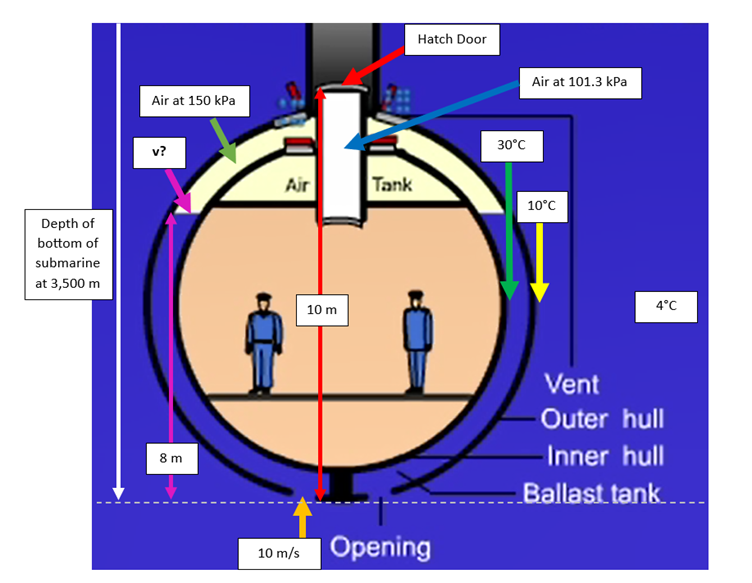hen the submarine is on the surface, its ballast tanks are filled with air. As the submarine dives, the ballast tanks are flooded with water and the air in the ballast tanks is vented from the submarine. The submarine descends from sea level and holds at a constant depth of 3,500m. Background Information Submarine Volume is 450 m3 Mass (excluding weight in ballast tank) is 400 tons Outer haul Mass is 40 tons Thickness is 15 cm Exterior surface area is 200 m2 Specific heat capacity is 420 J/kg/K Latent heat of fusion is 250 kJ/kg Temperature at surface (depth of 0 m) is 25°C depth of 3,500 m internal of the outer haul (
hen the submarine is on the surface, its ballast tanks are filled with air. As the submarine dives, the ballast tanks are flooded with water and the air in the ballast tanks is vented from the submarine. The submarine descends from sea level and holds at a constant depth of 3,500m. Background Information Submarine Volume is 450 m3 Mass (excluding weight in ballast tank) is 400 tons Outer haul Mass is 40 tons Thickness is 15 cm Exterior surface area is 200 m2 Specific heat capacity is 420 J/kg/K Latent heat of fusion is 250 kJ/kg Temperature at surface (depth of 0 m) is 25°C depth of 3,500 m internal of the outer haul (
Chapter2: Loads On Structures
Section: Chapter Questions
Problem 1P
Related questions
Question
When the submarine is on the surface, its ballast tanks are filled with air. As the submarine dives, the ballast tanks are flooded with water and the air in the ballast tanks is vented from the submarine. The submarine descends from sea level and holds at a constant depth of 3,500m.
Background Information
- Submarine
- Volume is 450 m3
- Mass (excluding weight in ballast tank) is 400 tons
- Outer haul
- Mass is 40 tons
- Thickness is 15 cm
- Exterior surface area is 200 m2
- Specific heat capacity is 420 J/kg/K
- Latent heat of fusion is 250 kJ/kg
- Temperature at
- surface (depth of 0 m) is 25°C
- depth of 3,500 m
- internal of the outer haul (next to ballast tank) is 10 30°C (Refer to diagram)
- external of the outer haul is 10°C (Refer to diagram)
- Thermal conductivity is 80 kW/m/K
- Emissivity of 0.9
- Ballast Tank at a depth of 3,500 m
- Temperature at is 30°C
- Seawater
- Specific gravity of 1.05
- Surrounding temperature at a depth of 3,500 m is 4°C
- Convective heat transfer coefficient for free convection is 75 W/m2/K
Calculate the change in heat energy of the submarine’s outer haul, when it descends from the surface to a depth of 3,500m.

Transcribed Image Text:Depth of
bottom of
submarine
at 3,500 m
Air at 150 kPa
v?
8 m
Air
10 m
Tank
Hatch Door
10 m/s Opening
30°C
Air at 101.3 kPa
10°C
4°C
Vent
Outer hull
Inner hull
Ballast tank...
Expert Solution
This question has been solved!
Explore an expertly crafted, step-by-step solution for a thorough understanding of key concepts.
Step by step
Solved in 3 steps with 4 images

Follow-up Questions
Read through expert solutions to related follow-up questions below.
Follow-up Question
Calculate the power of the submarine’s electrical heater needed, to maintain the interior of outer hull at 30°C. The exterior of outer hull is 10°C. (Assume heat of the submarine is only lost across the outer hull)
Solution
Knowledge Booster
Learn more about
Need a deep-dive on the concept behind this application? Look no further. Learn more about this topic, civil-engineering and related others by exploring similar questions and additional content below.Recommended textbooks for you


Structural Analysis (10th Edition)
Civil Engineering
ISBN:
9780134610672
Author:
Russell C. Hibbeler
Publisher:
PEARSON

Principles of Foundation Engineering (MindTap Cou…
Civil Engineering
ISBN:
9781337705028
Author:
Braja M. Das, Nagaratnam Sivakugan
Publisher:
Cengage Learning


Structural Analysis (10th Edition)
Civil Engineering
ISBN:
9780134610672
Author:
Russell C. Hibbeler
Publisher:
PEARSON

Principles of Foundation Engineering (MindTap Cou…
Civil Engineering
ISBN:
9781337705028
Author:
Braja M. Das, Nagaratnam Sivakugan
Publisher:
Cengage Learning

Fundamentals of Structural Analysis
Civil Engineering
ISBN:
9780073398006
Author:
Kenneth M. Leet Emeritus, Chia-Ming Uang, Joel Lanning
Publisher:
McGraw-Hill Education


Traffic and Highway Engineering
Civil Engineering
ISBN:
9781305156241
Author:
Garber, Nicholas J.
Publisher:
Cengage Learning